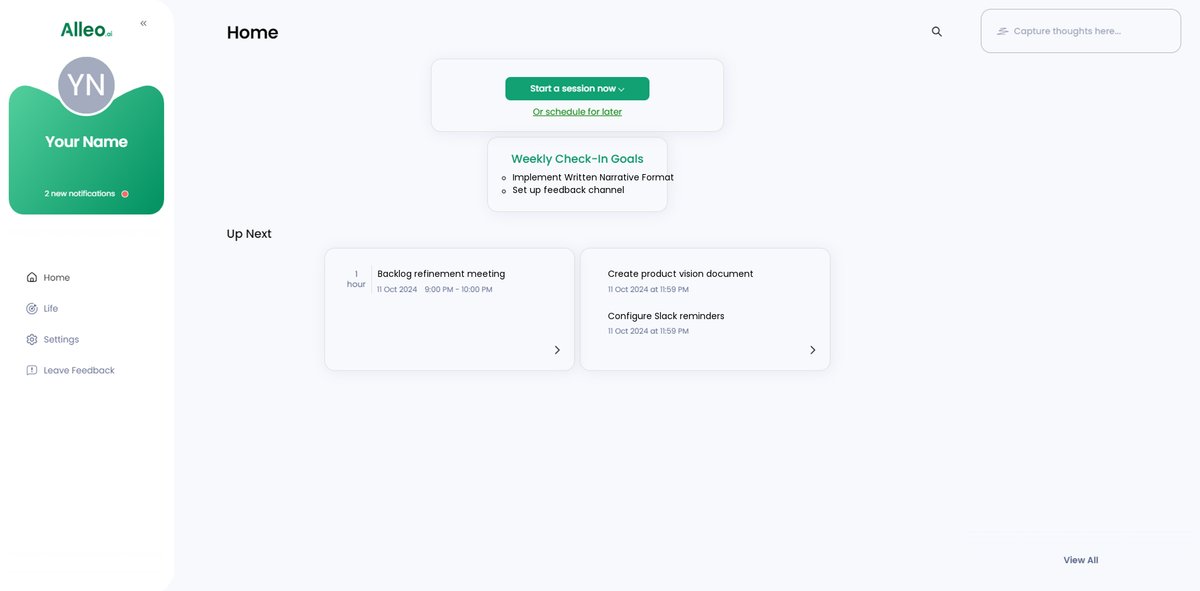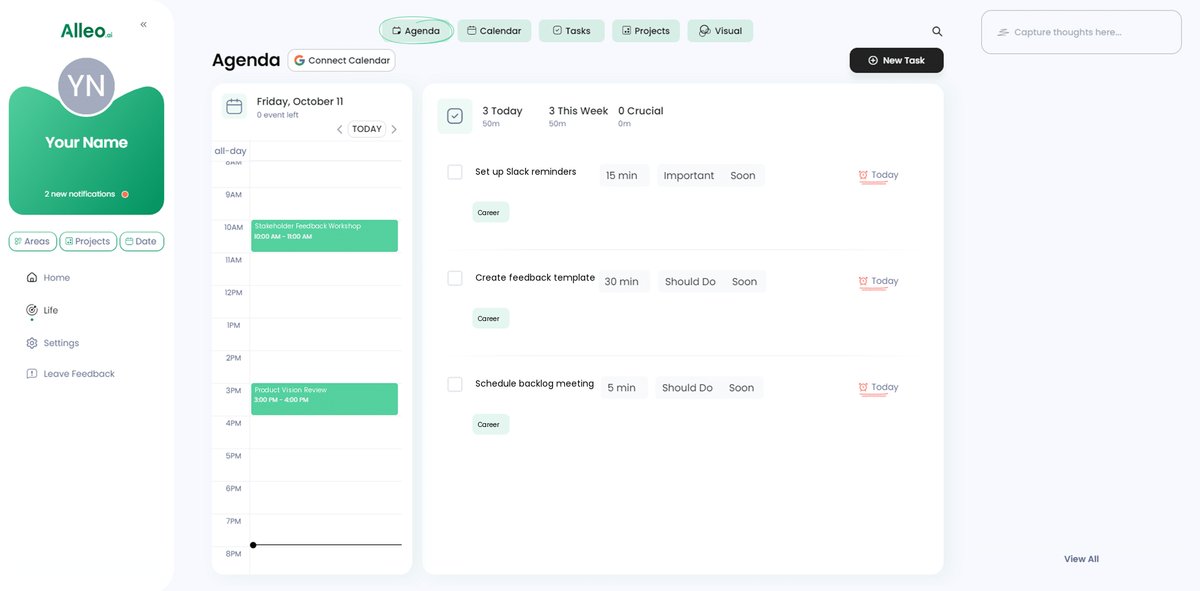7 Powerful Strategies for Product Managers to Master Asynchronous Stakeholder Feedback
Imagine trying to build a house where each contractor works independently, with little to no communication. The result? Chaos and misalignment. This scenario mirrors the challenges of managing asynchronous stakeholder feedback in product management.
Product managers face significant hurdles when dealing with asynchronous stakeholder feedback, especially in remote product development collaboration scenarios.
As a life coach, I’ve helped many professionals navigate these challenges in prioritizing stakeholder input asynchronously. In my experience, effective strategies for managing asynchronous stakeholder feedback make all the difference.
In this article, we’ll explore powerful tools and techniques for documenting asynchronous stakeholder feedback, like the Written Narrative Format, the RAPID decision-making framework, and more asynchronous communication tools for product management.
Let’s dive into these stakeholder feedback management techniques and explore how they can improve asynchronous decision-making in product development.

The Pain Points of Asynchronous Feedback
Managing asynchronous stakeholder feedback is a tough nut to crack for product managers. Misalignments, delays, and confusion often plague your efforts in remote product development collaboration.
Many clients initially struggle with stakeholders providing feedback at different times. This inconsistency leads to a disjointed understanding of project goals, highlighting the need for effective stakeholder feedback management techniques.
In my experience, misalignment can derail even the best-planned projects. Imagine trying to keep everyone on the same page when feedback trickles in sporadically, especially when balancing stakeholder expectations across time zones.
It’s frustrating, right?
Without a clear strategy for managing asynchronous stakeholder feedback, delays in decision-making become common. This hampers your ability to move forward efficiently in agile product management with distributed teams.
Several clients report feeling overwhelmed by the volume and inconsistency of feedback. These challenges underscore the need for effective strategies in prioritizing stakeholder input asynchronously and documenting asynchronous stakeholder feedback.

Key Strategies for Managing Asynchronous Stakeholder Feedback
Overcoming the challenge of managing asynchronous stakeholder feedback requires a few key steps. Here are the main areas to focus on to make progress in remote product development collaboration:
- Implement a Written Narrative Format system: Use a structured format for continuous collaboration and documenting asynchronous stakeholder feedback.
- Use RAPID framework for decision-making clarity: Define roles and streamline decision points for asynchronous decision-making in product development.
- Set up automated Slack reminders for feedback: Ensure timely and focused stakeholder input, addressing time-zone challenges in product feedback.
- Create a dedicated stakeholder feedback channel: Centralize feedback for easier management and prioritizing stakeholder input asynchronously.
- Schedule regular backlog refinement meetings: Align on priorities and tasks regularly, supporting agile product management with distributed teams.
- Develop a clear product vision document: Keep goals and strategies transparent to aid in balancing stakeholder expectations across time zones.
- Use visual tools like Miro for async collaboration: Facilitate interactive and visual planning as part of asynchronous communication tools for product management.
Let’s dive into these strategies for managing asynchronous stakeholder feedback!
1: Implement a Written Narrative Format system
Implementing a Written Narrative Format system is essential for managing asynchronous stakeholder feedback and maintaining alignment with stakeholders across time zones.
Actionable Steps:
- Create a comprehensive template: Develop a template that includes sections for context, objectives, and stakeholder feedback, facilitating remote product development collaboration.
- Train your team and stakeholders: Conduct workshops to educate everyone on effectively using the Written Narrative Format for continuous collaboration and asynchronous communication in product management.
- Schedule regular reviews: Set up periodic reviews to ensure the narrative remains up-to-date and relevant, addressing time-zone challenges in product feedback.
Explanation:
These steps are crucial because they foster a structured approach to communication. This method ensures clarity and consistency in stakeholder feedback management techniques.
According to Medium, using a Written Narrative Format enhances decision-making and keeps all parties aligned. This approach aligns with current industry trends emphasizing collaborative planning and continuous feedback in agile product management with distributed teams.
Key benefits of implementing a Written Narrative Format system:
- Improves communication clarity for managing asynchronous stakeholder feedback
- Enhances stakeholder alignment across time zones
- Facilitates more efficient asynchronous decision-making in product development
This structured system will help you manage asynchronous stakeholder feedback more effectively, supporting prioritizing stakeholder input asynchronously and feedback analysis for remote product teams.

2: Use RAPID framework for decision-making clarity
Achieving decision-making clarity is crucial for managing asynchronous stakeholder feedback effectively in remote product development collaboration.
Actionable Steps:
- Identify and define roles: Use the RAPID framework to assign specific roles for each key decision point in asynchronous decision-making in product development.
- Communicate the RAPID matrix: Share the RAPID matrix with all stakeholders to ensure everyone understands their responsibilities in prioritizing stakeholder input asynchronously.
- Implement a feedback loop: Continuously refine and improve the decision-making process based on feedback analysis for remote product teams.
Explanation:
These steps are important as they establish clear roles and streamline decision-making, which reduces confusion and delays in managing asynchronous stakeholder feedback.
According to Beyond the Backlog, the RAPID framework improves stakeholder alignment and decision-making efficiency. This approach aligns with trends emphasizing collaborative planning and continuous feedback in product management, especially when balancing stakeholder expectations across time zones.
Implementing the RAPID framework will help you manage stakeholder feedback more effectively and move forward with clarity in agile product management with distributed teams.
![]()
3: Set up automated Slack reminders for feedback
Setting up automated Slack reminders for feedback is crucial when managing asynchronous stakeholder feedback, ensuring timely and focused input from stakeholders.
Actionable Steps:
- Create regular reminder prompts: Use Slack’s reminder feature to set up daily or weekly prompts for stakeholders to provide feedback, an effective asynchronous communication tool for product management.
- Customize reminders: Tailor the reminders to include specific questions or discussion points to guide the feedback process, helping prioritize stakeholder input asynchronously.
- Monitor and adjust: Regularly evaluate the responsiveness and quality of feedback to fine-tune the frequency and content of reminders, addressing time-zone challenges in product feedback.
Explanation:
These steps are crucial as they help maintain a consistent flow of feedback, reducing misalignment and delays in remote product development collaboration.
According to Lenny’s Newsletter, using Slack reminders can significantly improve communication efficiency. This approach aligns with the trend of using digital tools to enhance remote collaboration and facilitate asynchronous decision-making in product development.
Implementing these automated reminders will streamline your feedback process and keep everyone aligned, supporting agile product management with distributed teams.

4: Create a dedicated stakeholder feedback channel
Creating a dedicated stakeholder feedback channel is crucial for managing asynchronous stakeholder feedback and ensuring clarity in remote product development collaboration.
Actionable Steps:
- Set up a dedicated Slack channel: Create a specific Slack channel for stakeholder feedback to keep all related discussions organized, facilitating asynchronous communication tools for product management.
- Establish posting guidelines: Develop clear guidelines for posting feedback to ensure it’s concise and relevant, aiding in prioritizing stakeholder input asynchronously.
- Assign a moderator: Designate a team member to manage the channel, organize feedback, and address issues promptly, supporting stakeholder feedback management techniques.
Explanation:
These steps are essential as they create a structured environment for feedback, reducing confusion and improving clarity in managing asynchronous stakeholder feedback.
According to Atlassian, effective documentation and feedback channels help keep team members aligned and informed, which is crucial for documenting asynchronous stakeholder feedback.
This approach supports current industry trends focused on collaborative planning and continuous feedback, essential for agile product management with distributed teams.
Implementing a dedicated feedback channel will streamline communication and enhance stakeholder alignment, addressing time-zone challenges in product feedback.
![]()
5: Schedule regular backlog refinement meetings
Scheduling regular backlog refinement meetings is crucial for aligning priorities and ensuring consistent progress in managing asynchronous stakeholder feedback.
Actionable Steps:
- Plan and schedule recurring meetings: Set up a regular schedule for backlog refinement meetings with all relevant stakeholders, considering time-zone challenges in product feedback.
- Prepare an agenda: Create an agenda that includes a review of recent feedback and prioritizing stakeholder input asynchronously.
- Document decisions and action items: Record key decisions and action items to maintain clarity and accountability, essential for documenting asynchronous stakeholder feedback.
Explanation:
These steps are essential because they help maintain alignment and ensure that all team members are on the same page when managing asynchronous stakeholder feedback.
According to Contentsquare, regular backlog refinement meetings improve understanding and buy-in across the team. This aligns with current trends emphasizing collaborative planning and continuous feedback in product management, especially for remote product development collaboration.
Key outcomes of effective backlog refinement meetings:
- Enhanced team alignment on priorities for managing asynchronous stakeholder feedback
- Improved product roadmap clarity through asynchronous decision-making in product development
- More efficient resource allocation for feedback analysis in remote product teams
Implementing these meetings will help keep your projects on track and stakeholders aligned, even when using asynchronous communication tools for product management.

6: Develop a clear product vision document
Developing a clear product vision document is crucial for managing asynchronous stakeholder feedback and maintaining transparency and alignment among stakeholders.
Actionable Steps:
- Draft a comprehensive product vision document: Outline your goals, strategy, and roadmap concisely, considering asynchronous communication tools for product management.
- Share the document with all stakeholders: Ensure everyone has access and solicit their input and feedback, prioritizing stakeholder input asynchronously.
- Regularly update the document: Reflect any changes in strategy or objectives to keep it relevant, addressing time-zone challenges in product feedback.
Explanation:
These steps are vital as they ensure that everyone understands the project’s direction and goals, facilitating remote product development collaboration.
According to Atlassian, effective product documentation helps keep team members aligned and informed, supporting asynchronous decision-making in product development.
This approach aligns with industry trends emphasizing transparency and continuous feedback, essential for managing asynchronous stakeholder feedback.
Implementing a clear product vision document will help you maintain alignment and clarity with your stakeholders, even when balancing stakeholder expectations across time zones.

7: Use visual tools like Miro for async collaboration
Using visual tools like Miro for managing asynchronous stakeholder feedback is crucial for enhancing interactive planning and stakeholder engagement in remote product development collaboration.
Actionable Steps:
- Introduce visual collaboration tools: Implement Miro to create interactive boards for specific projects or initiatives, facilitating asynchronous communication tools for product management.
- Encourage stakeholder contributions: Set up guidelines for stakeholders to add their input asynchronously on the Miro boards, addressing time-zone challenges in product feedback.
- Regularly review and integrate feedback: Schedule periodic reviews to discuss and incorporate feedback from the boards into your product planning, supporting asynchronous decision-making in product development.
Explanation:
These steps matter because they enable a more dynamic and engaging collaboration process for managing asynchronous stakeholder feedback.
According to Atlassian, using collaborative tools like Miro helps improve the quality and comprehensiveness of feedback, essential for prioritizing stakeholder input asynchronously.
This approach aligns with industry trends that emphasize the importance of visual collaboration and continuous feedback in product management, particularly for agile product management with distributed teams.
Benefits of using visual collaboration tools:
- Enhanced stakeholder engagement
- Improved idea visualization
- More effective asynchronous teamwork
Implementing these steps will enhance your team’s asynchronous collaboration and ensure better alignment in managing asynchronous stakeholder feedback.
Partner with Alleo for Asynchronous Feedback Management
We’ve explored the challenges of managing asynchronous stakeholder feedback, how solving them can benefit your projects, and the steps to achieve it. But did you know you can work directly with Alleo to make this journey easier and faster for prioritizing stakeholder input asynchronously?
Setting up an account with Alleo is simple. Sign up for a personalized plan tailored to your needs in managing asynchronous stakeholder feedback and overcoming time-zone challenges in product feedback.
Alleo’s AI coach will help you set up Slack reminders, manage feedback channels, and maintain your product vision document. The coach will follow up on your progress, handle changes, and keep you accountable via text and push notifications, enhancing your remote product development collaboration.
Ready to get started for free? Let me show you how to improve your asynchronous communication tools for product management!
Step 1: Sign In or Create Your Alleo Account
Log in to your existing Alleo account or create a new one to start managing your asynchronous stakeholder feedback more effectively.

Step 2: Choose “Building better habits and routines”
Select “Building better habits and routines” to develop consistent practices for managing asynchronous feedback, aligning with strategies like implementing a Written Narrative Format and setting up automated Slack reminders to streamline your workflow and improve stakeholder communication.

Step 3: Select “Career” as Your Focus Area
Choose “Career” as your focus area to address challenges in managing asynchronous stakeholder feedback, aligning with the article’s emphasis on improving product management and decision-making processes.

Step 4: Starting a Coaching Session
Begin your journey with Alleo by scheduling an intake session, where you’ll discuss your asynchronous feedback challenges and set up a personalized plan to implement the strategies outlined in this article.

Step 5: Viewing and managing goals after the session
After your coaching session, check the Alleo app’s home page to review and manage the goals you discussed, ensuring you stay on track with your product management and stakeholder feedback strategies.

Step 6: Adding events to your calendar or app
Easily add key events and deadlines to your calendar or app to track your progress in solving asynchronous feedback challenges, ensuring you stay on top of important milestones and tasks as you implement the strategies discussed.

Bringing It All Together
Managing asynchronous stakeholder feedback is challenging, but you now have the tools to tackle it effectively.
Remember, clarity and consistent communication are key in asynchronous communication tools for product management.
Implementing strategies like the Written Narrative Format and the RAPID framework can transform your workflow for prioritizing stakeholder input asynchronously.
Automated Slack reminders and dedicated feedback channels will keep everyone aligned, addressing time-zone challenges in product feedback.
Scheduling regular backlog refinement meetings and maintaining a clear product vision document are also crucial steps in stakeholder feedback management techniques.
Visual tools like Miro will enhance asynchronous collaboration within your team for remote product development collaboration.
You can do this.
Trust me, these strategies work for managing asynchronous stakeholder feedback.
Consider trying Alleo to streamline your process in documenting asynchronous stakeholder feedback.
Take the first step towards better stakeholder alignment today in agile product management with distributed teams.
Sign up for free and see the difference Alleo can make in asynchronous decision-making in product development!